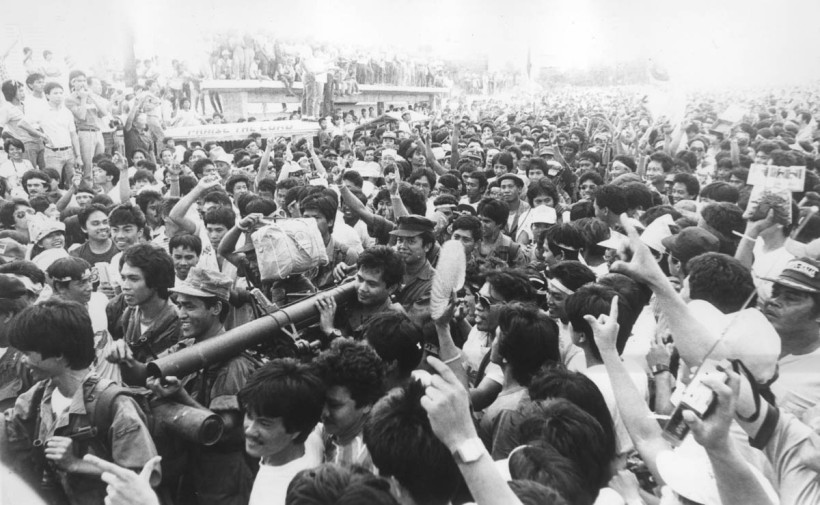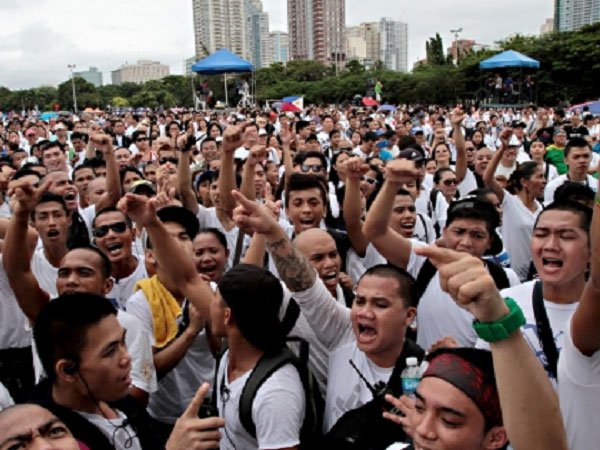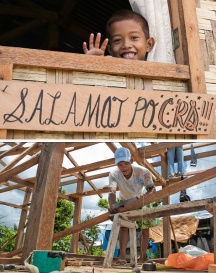History has two interrelated strands, Historical Knowledge and Understanding; and Historical Skills. Historical Knowledge and Understanding begins at a more realistic personal and local level and extends to including wider Australia and eventually the world. Historical Skills promotes skills used in the process of historical enquiry.
Economics and Business is organised into two related strands, Economics and Business Knowledge and Understanding; and Economics and Business Skills. There is no formal Economics and Business curriculum from Foundation to Year 4. They will none the less have the opportunity to develop relevant knowledge, understanding and skills through other learning areas.
EDSA(People Power Revolution)
Technology has played a crucial role in EDSA (people power revolution) the mobile phone served as the symbol of People Power II Evolution in the Philippines. Also, the most lasting image of Ms. Gloria Macapagal-Arroyo’s new presidency has, was when she was asked in a news conference, if Lt. Gen. Espinosa was planing a coup, and not knowing the answer, she directly called him using her mobile phone. After the brief conversation they had, she knew that Lt. Gen Espinosa isn’t planning a coup.
The use of mobile phones for texting rather than calling was intriguing at that time. It akso served as the reason of People Power II evolution’s success. But even if technology played a crucial role at that time, people haven’t drawn a lot of attention to it. People Power II was arguably the world’s first EDSA-Revolution’s change of government, brought by new form of ICTs (Information and Communications Technology).

President Estrada’s corruption was widely spreaded through texting. It helped to facilitate the protests at the EDSA Shrine, wherein it took only 88 hours to remove Estrada. The use of mobile phones was the reason why mobilization was large and rapid, and thus, so decisive. After what happened, Estrada blamed his ouster on the “text messaging generation.”
Mobile phone technology was not just critical on People Power II; it was also important over a number of months. Estrada ordered key goverment agencies to do something about alleged text-messages that are abusing him. The same week, texters started passing around messages using an exclamation mark (!) as a symbol to call for an end to the corruption, cronyism and incompetence of Estrada’s government.
Such great revolution is believed to be only possible in the Philippines. Manila is even said to be the texting capital of the world. Philippines, considered a poor country, prefer texting more than calling, because of the cost. Texting can be done by both hands, or one, while doing other stuffs, making Filipinos comfortable by doing so.
Modern ICTs facilitated and helped in ensuring that our country, the Philippines was the first location of political revolution. In the week of People Power II itself, there were 70 million text messages handled by Philippine Mobile. It was then reported by Reuters that technology is literally putting the power in Filipino peoples’ hand. We are given power to state feedbacks.
The Philippines’ case raised lots of big questions about the broader implications of technological advances on political action around the world. It was then possible to predict the exact outcomes, but evidences pointed in interesting directions.
The adaption of different technologies, particulary internet and mobile phones is staggering. At the same time, the technologies continue to upgrage. This continuous advances are spreading widely, making it possible to share informations and organize political action easily. The challenge now is to ensure that ICT is for the better, and not for the worse, and to be used by everyone, and not by few.
ICTs are unlikely to change the main principles of politics. But, it is unlikely to be the last time that stunning and sudden advances in ICTs played a crucial role in helping the people remove a corrupt leading. The people of the Philippines will have shown one way and for that we should thank “Text Brigade”.
EDSA dos
Information and Communication Technology(ICT) is an umbrella term that includes any communication device or application, encompassing: radio, television, cellular phones, computer and network hardware and software, satellite systems and so on, as well as the various services and applications associated with them, such as videoconferencing and distance learning. ICTs are often spoken of in a particular context, such as ICTs in education, health care, or libraries.

In l986 millions of unarmed Filipinos surprised the world by nonviolently overthrowing the brutal dictator Ferdinand Marcos, known at the time as “the Hitler of Southeast Asia.” They called their movement “people power,” demonstrating in an amazing way the power of active nonviolence, the power of truth and love, similar to what was seen in the Gandhian freedom struggle in India and the civil rights movement in the United States. Beginning with the assassination in l983 of the popular opposition leader Senator Benigno (Ninoy) Aquino, the movement against Marcos grew rapidly. Imprisoned for seven years by Marcos, Aquino had experienced a deep conversion in his concentrated study of the Bible and Gandhi. This led him to begin advocating a nonviolent revolution against dictatorship. His subsequent martyrdom fueled the determination of many Filipinos to continue in his radical nonviolent path. In 1984, the Little Sisters of Jesus, a community of nuns who worked among the poorest of the poor in metropolitan Manila, took it upon themselves to contact Jean and Hildegard Goss-Mayr, nonviolence lecturers and trainers in Europe who had worked for many years for the International Fellowship of Reconciliation (IFOR) in situations of revolution and war. The nuns asked the Goss-Mayrs, a French-Austrian couple, to come to the Philippines to help assess the situation. Having lived under Nazism in World War II, they were acquainted with struggling against tyranny. They came and met with church leaders (the country is over ninety percent Christian), peasants, labor and student leaders and community organizers. Out of these meetings came the decision to build a nonviolent movement that would oppose the dictatorship.
In order for Cory Aquino to mobilize a popular democratic movement, she needed Radio Veritas, a 24-hour AM radio station operated by the Roman Catholic Church, because it served as the primary communication platform for the democratic opposition. With all other non-government media shut down, Aquino and her cadres used Radio Veritas to inform Filipinos of political developments and organize them for nonviolent protests. After Ninoy Aquino was assassinated, Marcos prevented local media from broadcasting news of his death, and Radio Veritas, the only station in the Philippines to carry news of Senator Aquino’s assassination, galvanized the two million supporters to come to his funeral.According to former President of the University of the Philippines Francisco Nemenzo, “Without Radio Veritas it would have been difficult, if not impossible, to mobilize millions of people in a matter of hours.”
Million People March
The Million People March or the so-called “Pork Barrel Scam” was the first ever on-going series of protest in the Philippines held at the Luneta Park on the 26th day of August 2013, about the total abolition of the Pork Barrel or the Priority Development Assistance Fund scam which triggered the anger of the people through social medias such as Facebook and Twitter. Many Filipinos expressed their anger through creating blogs, pages, advertisements and even memes to show that they agree to the idea of stopping the Pork Barrel Fund.

For an instance, a Facebook event was entitled: “MILLION PEOPLE MARCH TO LUNETA AUGUST 26: SA ARAW NG MGA BAYANI, PROTESTA NG MGA BAYANI!!!” was created by Arnold Pedrigal and Bernardo Bernardo using the power of the social media to invite the people to join the protest for the pork barrel fund mess to be stopped. Their Facebook status says ” what we need is a MILLION PEOPLE MARCH by struggling Filipino taxpayers- a day of protest by the silent majority that would demand all politicians and government officials to stop pocketing our taxes borne out from our hard works by means of this pork barrel scams and other creative criminal acts.”
Another is a group of people called hacktivist or the PrivateX repaired at least 30 government websites early on August 26,2013, hours before the main protests. These includes the websites of the Philippine National Police and the Philippine Embassy in Rome.
ICT has almost become the platform of change because the protest is mostly organized through social media channels. Through this millennial tool, Filipinos, once again showed their love for their country and for the people who works hard for their living that pays their taxes veraciously yet some government officials or NGO’s won’t do the same thing and pockets the money of their countrymen. As time goes by, social medial will always be a part of our great history because no matter what the situation is, Filipinos will surely fight for what is right, cry for what is just and tussle for what is best for our country by the means of everything.
SOURCE/S:
https://globalvoices.org/2013/08/27/million-people-march-against-corruption-in-the-philippines/
Yolanda People Finder
Through online platforms, people posted calls for help, survivors let the world know they were safe, and photos and videos were posted to describe the situation on the ground, and help plan relief efforts. Maybe you even donated money online to one of the many emergency relief funds set up in the wake of the disaster. The role of social media in the Haiyan response highlighted the role of information and communications technology (ICT), communication, and civic participation in promoting social change indeed, the world has become hyper-connected.
The team presented data that showed tha t technologies are not often taken up by Yolanda-affected communities to give feedback to NGOs or fundraise for themselves. Low-income people relocated to tent cities and bunkhouses lack media access, social capital, and even personal confidence to voice their concerns in social media or in proprietary platforms such as humanitarian radio or Frontline SMS. The team observes that mostly middle-class people, with existing resources and strong social networks, have been able to use new technologies in community mobilizing and problem-solving.
t technologies are not often taken up by Yolanda-affected communities to give feedback to NGOs or fundraise for themselves. Low-income people relocated to tent cities and bunkhouses lack media access, social capital, and even personal confidence to voice their concerns in social media or in proprietary platforms such as humanitarian radio or Frontline SMS. The team observes that mostly middle-class people, with existing resources and strong social networks, have been able to use new technologies in community mobilizing and problem-solving.
Why we should give great honor and importance to ICT or in our technology when the time that we are suffering to the most destructive typhoon in Philippines history ?
Technology helps the yolanda victims to deliver their messages to the government through different social media like Facebook, Twitter, Instagram and many other useful apps. As we all know Philippines is one of the most many user in facebook. Websites, blogs, videos, tweets , can also used to broadcast and accessed across the country and even internationally.
BENEFITS :
>It helps to spread the information about the current situation of the victims.
>It helps to locate where the victims are.
>It helps to connect with people, and to inform them about important issues affecting their lives and their communities.
>It helps to know what are the different needs of the yolanda victims.
The role of it is when your family or relatives are missing on the situation of typhoon.You can easily find them by helping technology. How ? it is easy, you can find them by any technology gadgets. For example, someone in your family members are missing and you need to find them you can visit the government page and search your missing relative if their alive or not.
REFERENCE:
http://www.admu.edu.ph/ls/soss/news/research/workshop-icts-disaster-recovery-one-y
https://blogs.adb.org/blog/yolanda-response-shows-power-virtual-citizen